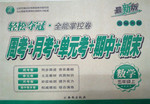题目内容
If a computer crashes, you will lose the file you on unless you save it regularly.
A.are working B.work C.will work D.worked
A

 轻松夺冠全能掌控卷系列答案
轻松夺冠全能掌控卷系列答案Battle of the Books
Each year in April, the “Battle of the Books” teams from each school meet for the Semi-Battle competition. The top three teams from each division go on to the Final Battle to compete for gold, silver and bronze medals. The gold medal winners go on to compete in the Regional Championship.
Battle of the Books Rules and Goals
Goals:
Students: Have fun reading good books from a wide variety of authors and genres(体裁).
Educators: Encourage reading, foster friendly competition, and nurture the love of books in young people.
Rules:
One team of six students from grades 7 or 8 will represent each school.
1. Each team will have a spokesperson. While the team is encouraged to discuss possible answers, team answers will only be accepted from the spokesperson.
2. The Semi-Finals will consist of three rounds of play, and the Finals will have one round. Each round features a Regular Battle and a Lightning Battle.
3. Regular Battle questions will be addressed to teams alternately(轮流地), regardless of the last correct answer. There will be 12 Regular Battle questions per round. When asked a question, teams will have 20 seconds to provide the book’s title and author.
4. Five points will be given if the team correctly identifies the exact title, and three points will be awarded for correctly identifying the author’s surname. The author’s first name does not need to be identified.
5. The Lightning Battles will be featured at the end of each round. Lightning Battles consist of a 2 minutes, 30 seconds time period during which each team is asked up to 12 questions. These questions concern details of the books and will not require teams to identify titles or authors. Each correctly answered Lightning Battle question will be worth three points.
PLEASE NOTE:
A warm-up practice question will be given to each team at the beginning of its first Semi-Battle and at the beginning of the Final and Regional Final Battles.
There may be no assistance from the coordinators and audience members.
Teams will not be punished for incorrect answers.
Any team demonstrating poor sportsmanship will not be invited back.
【小题1】According to the text, “Battle of the Books” is an activity ______.
| A.where students are inspired to write books |
| B.where books are used as arms in the battle |
| C.where friends compete with each other |
| D.where readers are motivated to love books |
| A.72 | B.24 | C.36 | D.12 |
| A.Teams are given 20 minutes to answer a question. |
| B.A competitor gets 18 points for 6 correct titles. |
| C.Each round ends with the Lightning Battles. |
| D.A correct first name will be given 5 points. |
| A.won’t be given a warm-up practice | B.won’t get help from audience members |
| C.will be reduced in its points | D.won’t be allowed to compete next time |
Sitting on a chair all day in school can make anyone want to move around. So, more and more teachers are letting students have a ball. By sitting on exercise balls instead of chairs , teachers find students’ posture(姿势) and attention improve.
Dottie Pownall, a fifth-grade teacher in West Virginia, USA, has been using balls as chairs since December 2008. “The students love them”, she says. Pownall took a survey(调查) of her students. She found that 80% of the students thought sitting on the balls helped them pay more attention to what they were learning.
The teacher, Pisa Witt, felt so strongly about the use of balls as chairs, she started Witt Fitt. This company encourages the use of the balls. And the company educates not only teachers but also students on how to use them. “Our products are used in 24 states, three provinces in Canada, Puerto Rico (波多黎各) and Japan,” says Witt, “ Research shows that sitting on the balls makes them sit up straighter(直的). You can slouch(低头垂肩地坐)on a ball,” says Witt, “but it feels bad.” Because the students are moving, their blood (血液) increases. That carries more oxygen( 氧气) to the brain , so the kids have more energy and can pay attention longer.
“Besides, they’re fun.” says Pownall.
【小题1】What will happen if a student sits on a chair all day in school? The student will_________.
| A.pay more attention to his lessons | B.be fun |
| C.like to move around | D.sit up straighter |
| A.About four years. | B.Only one year. |
| C.In 2008. | D.Since he was a fifth-grade teacher. |
| A.Four. | B.Three. | C.Two. | D.One. |
| A.improve the students’ posture and attention |
| B.slouch on the chairs |
| C.have fun |
| D.Both A and C are correct answers |
| A.Sitting on a chair. | B.Sitting on a ball. |
| C.They are the same. | D.We don’t know. |